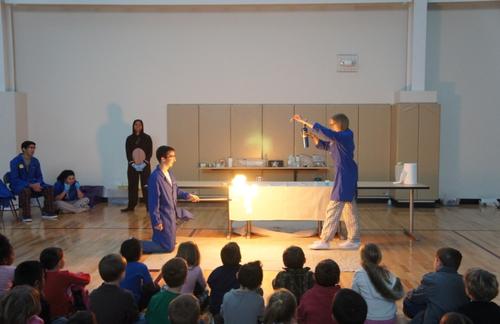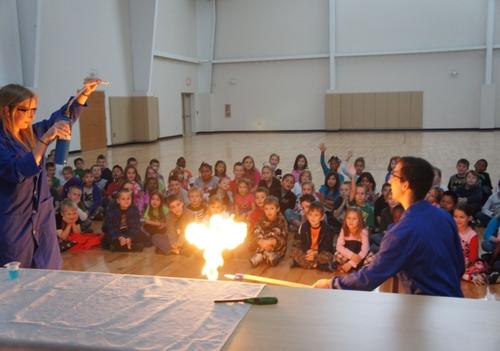 Propane Bubbles continues to be one of our most popular demonstrations among audiences and presenters alike. Propane-filled soap bubbles are generated, released into the air, and then ignited. The glowing ball of fire always elicits “oohs” and “ahhs” from everyone, young and old! This demonstration illustrates several physical and chemical properties of propane.
Propane Bubbles continues to be one of our most popular demonstrations among audiences and presenters alike. Propane-filled soap bubbles are generated, released into the air, and then ignited. The glowing ball of fire always elicits “oohs” and “ahhs” from everyone, young and old! This demonstration illustrates several physical and chemical properties of propane.
Numerous advantages of this demonstration make it an ideal activity for chemistry outreach presentations. The needed materials are readily available, inexpensive, long-lasting and easily transported. The demonstration itself is easy to learn, requires minimum advanced preparation and setup time, can be performed indoors or outdoors and is safe with proper precautions. Its versatility and engaging nature allow it be adapted to suit a wide range of venues, formats and audiences. We’ve incorporated Propane Bubbles into larger shows and as a stand-alone audience-participation activity.
 Concepts
Concepts
Physical properties: Propane is a colorless, odorless gas; propane-filled soap bubbles are denser than the surrounding air.
Chemical properties: Propane is flammable.
Combustion: Requirements for a combustion reaction — a fuel source (propane), oxygen (present in the air), and an ignition source (candle flame); possible discussion about activation energy (kinetics) and complete versus incomplete combustion (reaction stoichiometry).
Materials
- 10” (25 cm) candle; taper candles work well
- Long wooden stick (¾” x ¾” square, about 36” (91 cm) long works well, available at most lumber stores)
- Duct tape (to attach candle to end of wooden stick)
- Butane lighter or matches (to light candle)
- Soap solution (see advanced preparation)
- Plastic cup (to hold the soap solution)
- Portable cylinder of propane gas (Bernzomatic® Model #304182 or similar, available at most hardware stores. In 2012, Home Depot® sold cylinders for $2.98.)
- Attachment nozzle for propane with the air regulator removed (Bernzomatic® Brass Torch Model #329207 or similar, a one-time purchase available at most hardware stores. In 2012, Home Depot® sold the attachment for $11.98.)
- Tygon® tubing (10” long, 7/16” OD – 5/16” ID; available at most hardware stores)
- Paper towel and scissors (to cut paper towel)
- Rubber band (to secure paper towel to the tubing)
- Tarp (to protect floor from wax drippings)
Safety
- Two trained individuals are required to perform this demonstration: one to generate the propane-filled soap bubbles and one to ignite the bubbles or guide a member of the audience as he or she attempts to ignite them. Do not allow anyone who is not trained to ignite the bubbles without proper supervision.
- Wear safety glasses; long hair should be tied back.
- Fire hazard exists; be sure all flammable materials have been removed from the area. Check local fire regulations before performing this demonstration indoors.
- When generating the propane-filled soap bubbles hold the apparatus up as high as you can and then step backwards away from the bubble after it has been released.
- When igniting the bubbles hold the lighted candle attached to the long stick low to the ground away from the person generating the bubbles. Do not attempt to ignite bubbles that travel near anyone in the area, including you.
- If performing the demonstration outdoors, do so only on a calm day or in an area that blocks the wind currents.
- Be sure to turn off the propane when finished with performing the demonstration.
Advanced preparation
The soap solution is composed of 6-parts water, 1-part glycerin, and 1-part Dawn® dishwashing liquid by volume. After combining the three, allow the mixture to stand in the open air to allow volatile substances to evaporate; the longer the mixture “ages” (weeks) the better the soap bubbles.
Remove the air-regulator piece from the brass-torch nozzle. It is not needed for this demonstration. Attach the Tygon® tube to the remaining part of the nozzle. Be sure it is securely attached. Cut a piece of paper towel roughly 8” (20 cm) long and 2.5” (6 cm) wide. Fold it in half length-wise. Wrap it around the open end of the Tygon® tube, but do not cover the opening itself. Secure the towel to the tubing with the rubber band.
Secure the candle to the end of a wooden stick using duct tape.
Spread out a tarp on the floor in the area where the demonstration will be performed. Check to see if the tarp slips over the floor; if it does, secure with tape to avoid someone slipping on it.
Procedure
- Open the valve on the propane cylinder until you can hear the propane exiting.
- Dip the end of the tubing into the cup of soap solution.
- Hold the end of the tubing so that the end is in a vertical position pointing downward towards the floor.
- As a soap bubble forms, gently flick the tube to release it. Step backward away from the bubble after being released.
- Ignite the free-falling soap bubbles using the lighted candle that is attached to the wooden stick. Rotate the stick periodically so that the candle burns evenly.
- Extinguish the candle flame and turn off the propane when finished performing the demonstration.
Cleanup and disposal
- Remaining soap solution can be reused; return it to the storage bottle.
- Remove the nozzle from the propane cylinder.
- Check local regulations for recycling or disposal of empty propane cylinders.
Katie Gaddis has co-presented Propane Bubbles as a stand-alone station outdoors for children/parents attending our Science under the Stars event and indoors as part of a demonstration show for a local second-grade class. Katie’s participation in these events was part of her fulfillment of the requirements for the Chemistry Outreach Service Learning Course. The following are her thoughts and reflections about learning the demonstration and presenting it at these two events.
Propane Bubbles was the first demonstration I learned as part of my outreach course. As partners, we were assigned a demonstration to learn and present to the class. It was my favorite from the very beginning. Not having had any prior presentation experience, the most difficult part was getting started. We weren’t sure how to introduce the experiment to the audience in a way that would captivate them and keep them engaged throughout. With Dr. Lyle’s help, we determined that an effective way to engage an audience is through the use of well-designed questions and audience participation. We started off with questions: “Has anyone heard of propane? Like maybe when your dad is making hamburgers out on the grill?” We hoped by introducing something familiar, we would get the audience interested. Throughout the course, this idea of relating concepts back to the familiar was revealed as a critical component of an engaging presentation. We learned that using known, real-world examples can help convey difficult concepts.
At my first outreach event, it was challenging to present and explain the concepts at an appropriate level for a diverse audience. We introduced the experiment at our station by asking about the audience’s familiarity with propane and soap bubbles. Then we informed them that we were going to see what happens when we fill soap bubbles with propane. Either my partner or I would dip the end of the tube into the soap solution, remove the tube, generate the bubble and flick the tube releasing the bubble and allowing it to fall to the ground. We asked whether the propane-filled bubbles were more or less dense than the surrounding air. The older kids were readily able to answer that the bubbles were more dense but a few of the younger ones needed some guidance. The other presenter then lit the candle and used the candle flame to “catch” a bubble, which produced a huge ball of fire floating in midair. We explained that propane was a flammable substance, which is why the bubbles catch on fire, while bubbles filled with normal air do not. With our guidance, the children, one at a time, were given the opportunity to hold the long stick with the lighted candle and try to ignite the bubbles. Everyone successfully lit a bubble and was excited about having done so.
The Propane Bubbles demonstration was one of the most engaging at this event. Several children returned again and again to ignite the bubbles. The kids were eager to respond to our questions telling us about their families, grills and bubbles at birthday parties. Afterwards we received feedback that students could not stop talking about what they had seen, including the Propane Bubbles. This gave me the sense that we had made a positive impact on these young minds.
Based on the audience response, I could tell Propane Bubbles would always be a crowd favorite. Even if there is not complete comprehension of the underlying science, this demonstration serves as a great way to spark curiosity and get the students interested in science.
*Katie Gaddis is a Duke University senior majoring in neuroscience with minors in chemistry and dance. Upon graduation, she will begin working for Deloitte Consulting’s Global Benchmarking Center in Atlanta GA.
**Dr. Kenneth Lyle, a lecturing-fellow in the Department of Chemistry at Duke University, serves as the lecture-demonstrator and chemistry outreach coordinator.







